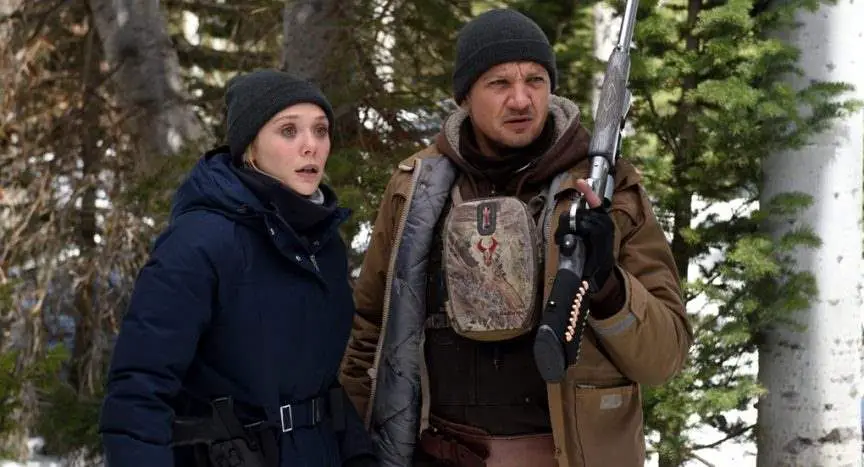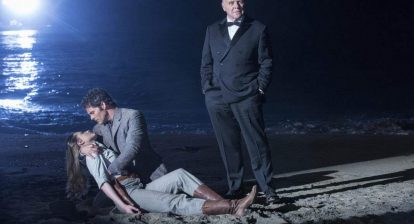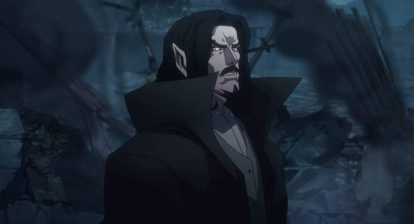Similar to the last edition’s chilly Hold The Dark, Wind River‘s horrors exist in a harsh landscape that while beautiful also masks their darkness beneath layers of untouched, pure white snow. The directorial debut from wonder-writer Taylor Sheridan (NQH classics Sicario and Hell or High Water), who handles scripting duties here too, naturally, is a stark and frequently stomach-dropping real-world horror story with a sting in its tail that’s impossible to forget.
See Also: Not Quite Horror: Hold The Dark
The premise, oddly enough, hinges on something of an Avengers reunion as Jeremy Renner (AKA Hawkeye) and Elizabeth Olsen (AKA Scarlet Witch — where is her standalone movie you cowards?) team up to solve a murder on an isolated Native American reservation in Wyoming. Renner is local hard-ass Cory, whose ex-wife is Native American, which gives him a keen understanding of the plight of native peoples. Olsen is Jane Banner, a name only a man could come up with, an FBI agent who turns up without a coat.

The Martha Marcy May Marlene star is such a sophisticated, accomplished actress that Jane never feels like a punchline, even when she’s being picked on or underestimated by local law enforcement. Cory isn’t even really supposed to be helping her, but his area knowledge proves indispensable in a climate a Las Vegas-based agent (originally from Florida, where it’s also warm!) has no understanding of. They form a bond but it never so much as flirts with romance, rather they have a grudging respect for each other.
DOP Ben Richardson shoots the wide, expansive landscapes lovingly, with a keen eye for how difficult life is out in the wilderness. Similarly to Hold The Dark, there’s a sense that bad things happen here without too much fallout. Who cares when there’s nobody around? Cory is battling against the system as well as his own demons. Likewise, Jane’s city eyes are opened to the struggles of native people whose lives were torn apart by gentrification, and left to fend for themselves. It’s assumed she’s not really there to help, since nobody cares in the first place.
Wind River‘s horrors primarily deal with the rape and murder of a young native woman, who made the mistake of falling in love with a white man (The Punisher himself, Jon Bernthal) and paid the price. The film takes a long time getting to the actual crime itself. When it does finally happen, Sheridan doesn’t shy away from the violence or cruelty. He wants us to feel each blow, the helplessness, the lack of care for a human life. The sequence is difficult to watch but not exploitative, focusing instead on this woman’s warrior spirit to stay alive (she ran for miles barefoot in the snow).

Likewise, when it’s time to bring her assailants to justice, Sheridan pulls the rug out from under us with a bloody, messy shootout (similar, again, to Hold The Dark though not as protracted). The real punishment comes when Cory brings the worst of the bunch out into the wilderness to deliver some frontier justice of his own. Echoing the sad fate of the murdered woman, he leaves the man to run barefoot through the snow for as long as possible, thereby exemplifying what a fighter his victim was in comparison (The Hateful Eight did something similar, albeit in a more garish manner).
Given this is Native American territory, beloved Comanche character actor Gil Bermingham (who also starred in Hell or High Water) plays the murdered woman’s father, a stoic, proud man who paints his face in mourning colors for the film’s final, emotional gut punch. His Martin is a longtime friend of Cory’s who mistrusts Jane at first but soon comes to realize how a woman might play a key role in understanding what his daughter went through. Sheridan makes the point that violence occurs most prominently in those dark corners everybody is turned away from, which are often in plain sight, as seen in Martin’s drug-addicted son.
Related: Not Quite Horror: Hell or High Water
He ends the film on that final image of Cory and Martin silently looking out over the landscape below, the snow melting as the weather changes. A title card alerts us to the fact there are no records on missing native women, as opposed to virtually every other demographic in America. It’s a fittingly harsh note to end on, but it also gives Wind River a sense of hope, as though things might change for the better it outsiders only took a closer look at what’s really going on out on the fringes of society. Olsen’s Jane Banner dissolves into uncontrollable tears when faced with what happened to the native woman, and it’s hard not to cry with her.







